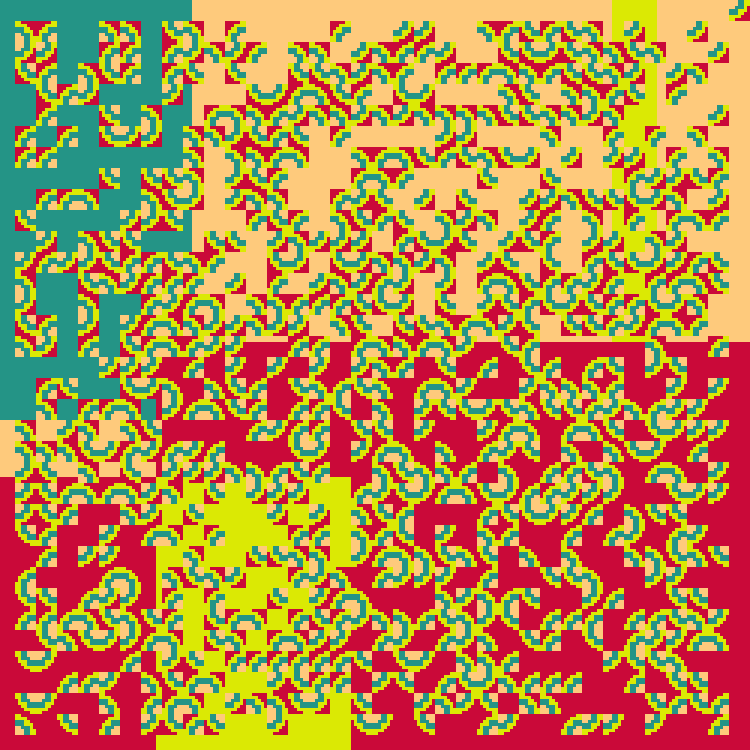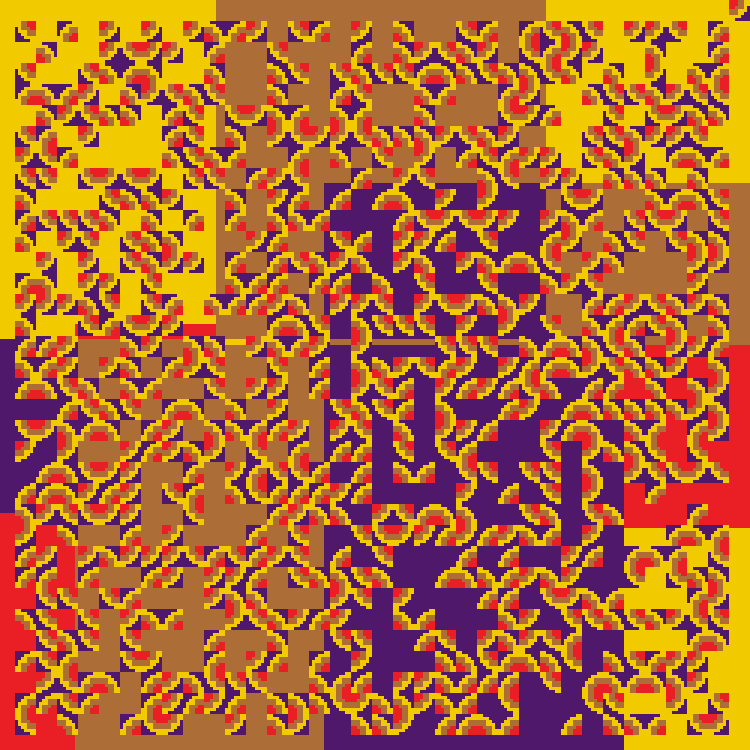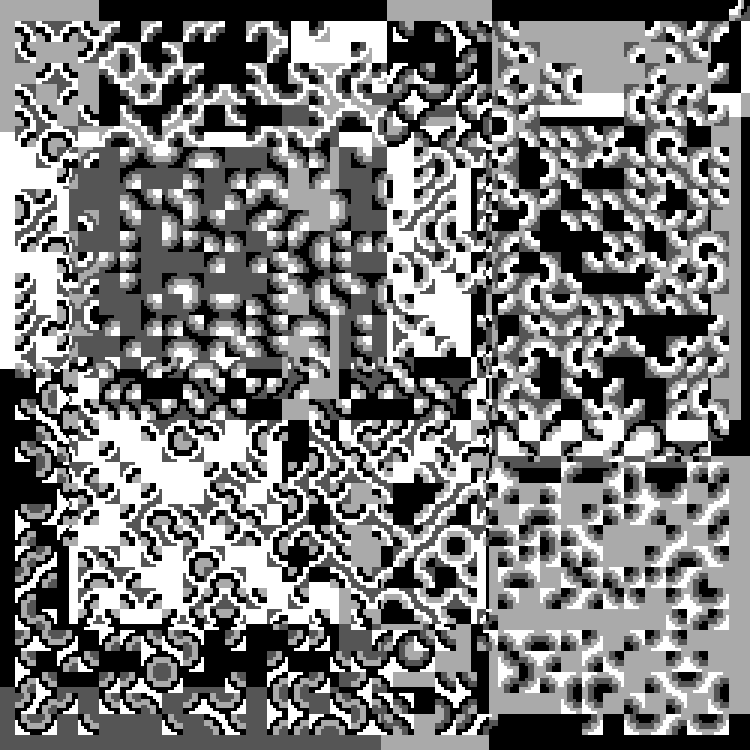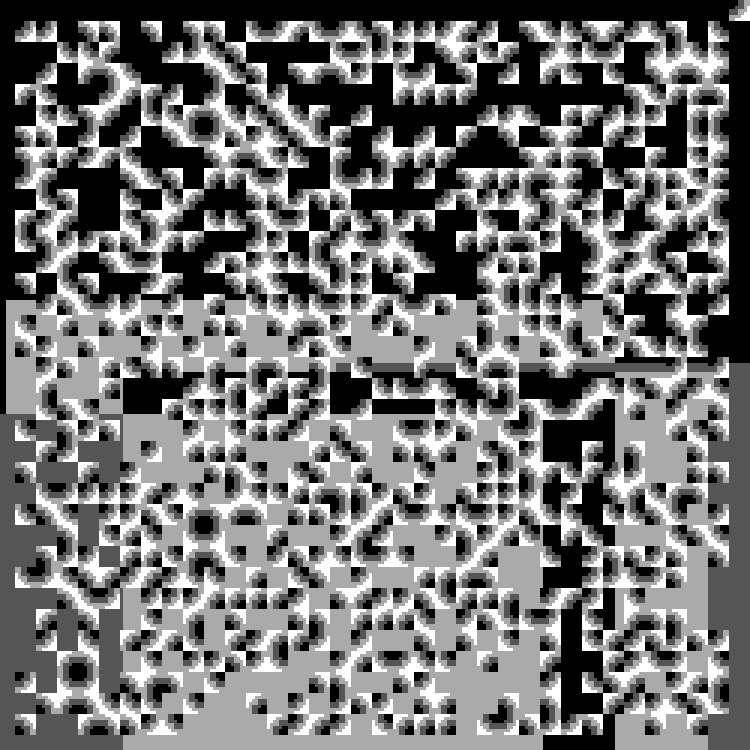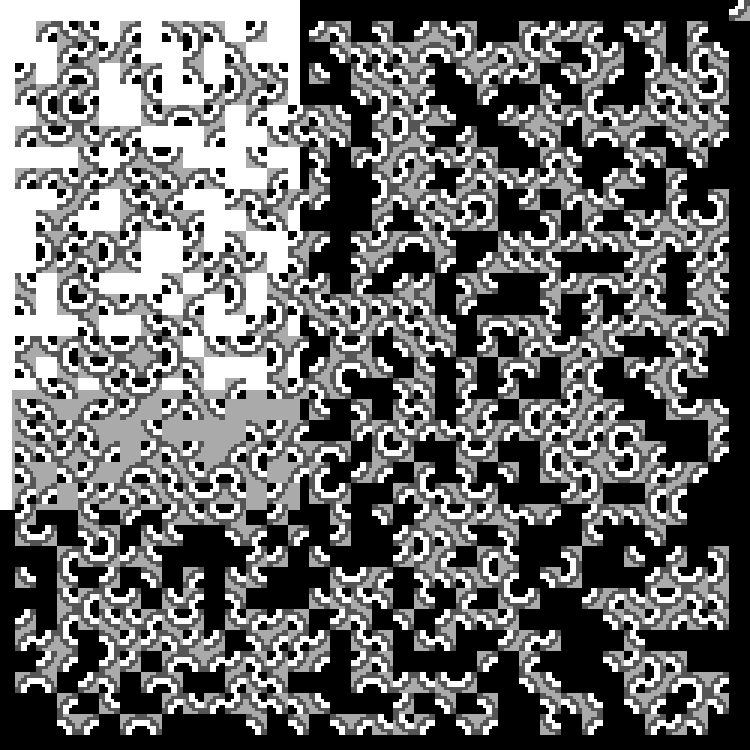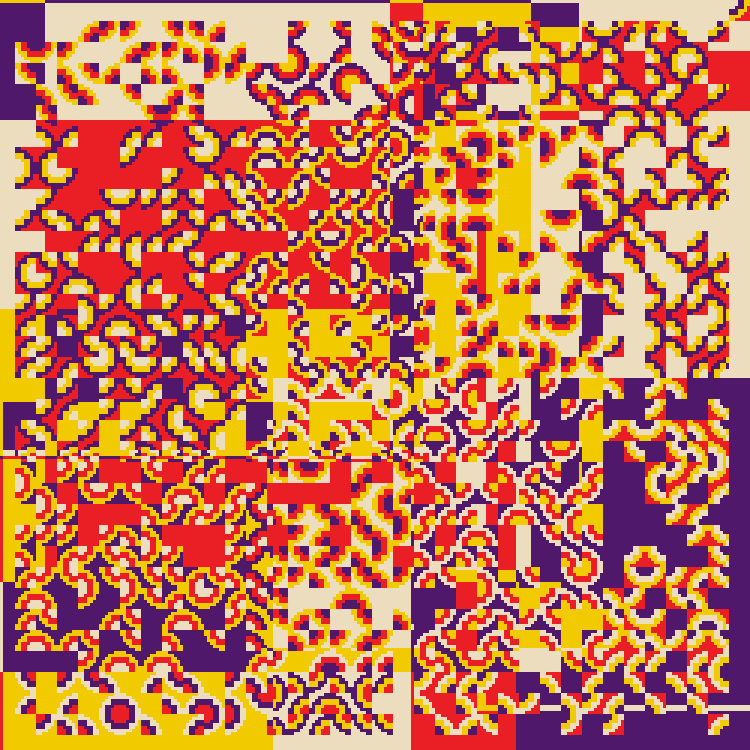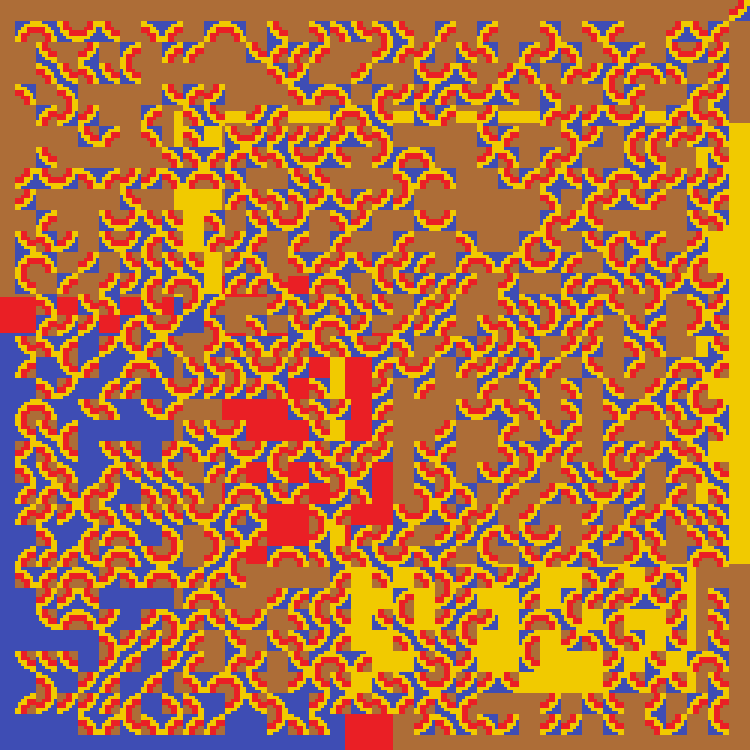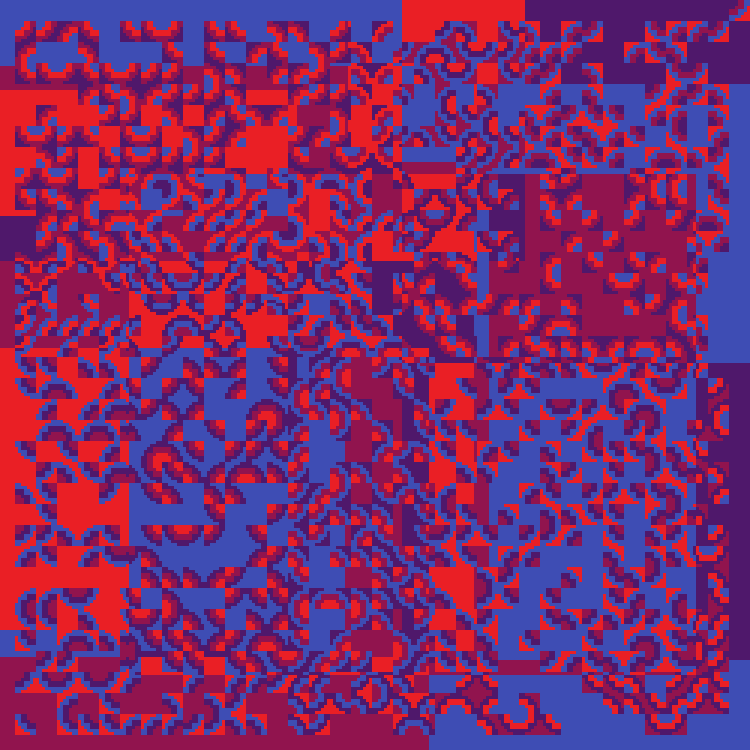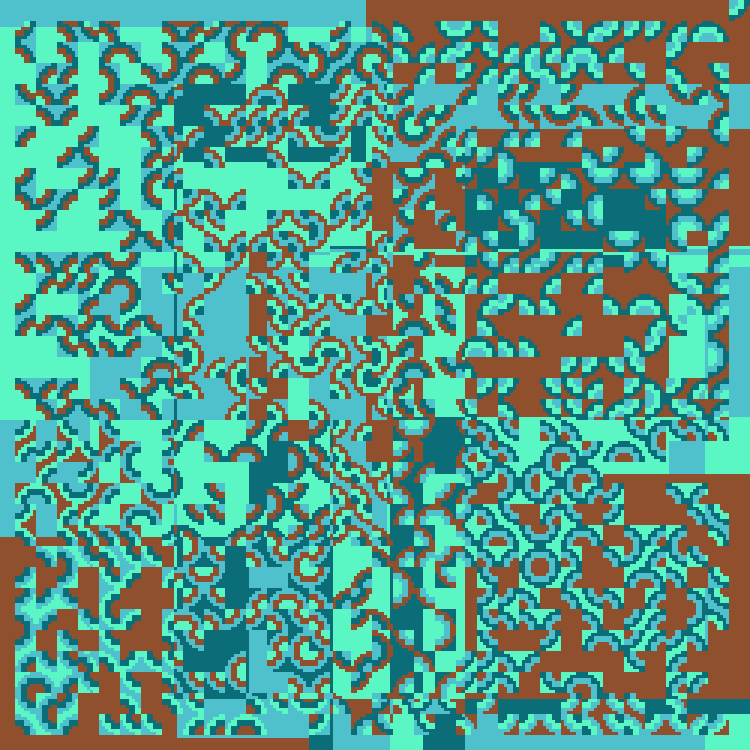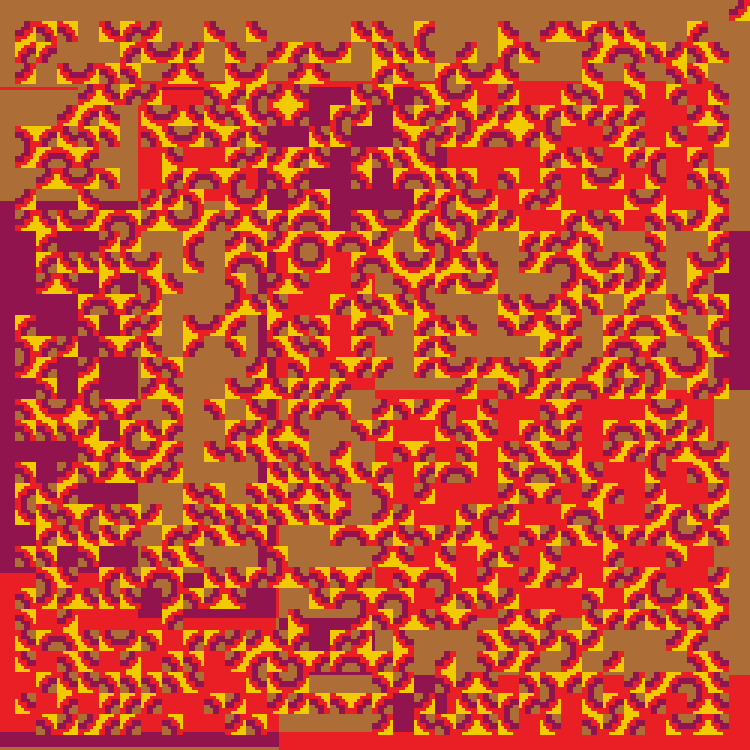Juxtaposition
IPFS

3 August 2022•TEZOS•IPFS
This is the third in series of works where we pay homage to Ken Knowlton, scientist and computer graphic pioneer and artist who passed on June 16, 2022. Ken Knowlton developed the famous EXPLOR language, (Explicit 2-D Patterns, Local Operations, and Randomness) while at Bell Labs. He published a paper describing it in 1975 entitled: MINI-EXPLOR, A FORTRAN-Coded Version of the EXPLOR Language for Mini (and larger) Computers. (https://dl.acm.org/doi/10.1145/988049.988052)
This work is a mark of progress. Christopher Scussel and I are working on modernizing MINI-EXPLOR. Chris is working on updating the engine from the original FORTRAN code of the 1970’s and its other limitations to usable JavaScript. In concert, I am analyzing and synthesizing the capabilities of the code and identifying an aesthetic. Together we continue to update EXPLOR and add new features.
Juxtaposition is based on Randomly Oriented Juxtaposed Modules (Test Example 1) that was published in Knowlton's paper describing MINI-EXPLOR in 1975.
The image is built up in layers. The first or background layer is drawn using randomly placed and sized areas of the picture space using EXPLOR’s CHANJ function. It breaks the background up into areas of color.
The second layer is a regular grid of juxtaposed tiles. To create more figure-ground relationships a tile is drawn only 67% of the time. The tile in this piece consists of a 7x7 block of cells is defined by the artist. This particular tile was constructed to represent a quarter circle of colored rings. Initially this tile needs to be placed in the image (it's in the upper right corner). It is this tile or, block of cells, that is cloned and manipulated using EXPLOR’s COMBN function. The COMBN function does more than just copy the block and place it, it has an extensive parameter list that determines what happens to the color of each cell relative to the block of cells placement (a set of rules) and it can orient the tile in 8 predefined ways. Applying randomness to the function's parameters causes a simple or complicated “combination” of two picture areas.
The last layer is subject to chance and is only executed 25% of the time. I run the background layer algorithm over the image one more time using another set of rules to alter the existing colors of all the cells in the image. Making the image even more complex and chaotic.
In keeping true to an EXPLOR vibe we use 4 color palettes. We let the computer randomly pick from three predefined palettes: Black and white. Four colors randomly chosen from set of 8 “Bauhaus” colors. And, four truly random colors.
We continue to honor the passing of Ken Knowlton with this NFT series. Here is an opportunity to collect an example image from the famous program he authored now updated by Scussel and Kolomyjec. A true piece of Computer Graphic Art history with a modern twist.
(c)2022 Dr. Bill Kolomyjec and Christoper Scussel. All rights reserved.
This work is a mark of progress. Christopher Scussel and I are working on modernizing MINI-EXPLOR. Chris is working on updating the engine from the original FORTRAN code of the 1970’s and its other limitations to usable JavaScript. In concert, I am analyzing and synthesizing the capabilities of the code and identifying an aesthetic. Together we continue to update EXPLOR and add new features.
Juxtaposition is based on Randomly Oriented Juxtaposed Modules (Test Example 1) that was published in Knowlton's paper describing MINI-EXPLOR in 1975.
The image is built up in layers. The first or background layer is drawn using randomly placed and sized areas of the picture space using EXPLOR’s CHANJ function. It breaks the background up into areas of color.
The second layer is a regular grid of juxtaposed tiles. To create more figure-ground relationships a tile is drawn only 67% of the time. The tile in this piece consists of a 7x7 block of cells is defined by the artist. This particular tile was constructed to represent a quarter circle of colored rings. Initially this tile needs to be placed in the image (it's in the upper right corner). It is this tile or, block of cells, that is cloned and manipulated using EXPLOR’s COMBN function. The COMBN function does more than just copy the block and place it, it has an extensive parameter list that determines what happens to the color of each cell relative to the block of cells placement (a set of rules) and it can orient the tile in 8 predefined ways. Applying randomness to the function's parameters causes a simple or complicated “combination” of two picture areas.
The last layer is subject to chance and is only executed 25% of the time. I run the background layer algorithm over the image one more time using another set of rules to alter the existing colors of all the cells in the image. Making the image even more complex and chaotic.
In keeping true to an EXPLOR vibe we use 4 color palettes. We let the computer randomly pick from three predefined palettes: Black and white. Four colors randomly chosen from set of 8 “Bauhaus” colors. And, four truly random colors.
We continue to honor the passing of Ken Knowlton with this NFT series. Here is an opportunity to collect an example image from the famous program he authored now updated by Scussel and Kolomyjec. A true piece of Computer Graphic Art history with a modern twist.
(c)2022 Dr. Bill Kolomyjec and Christoper Scussel. All rights reserved.
I've been involved in making art with the computer since the early 1970's. I’m one of the few early pioneers who’s still practicing Generative Art today.
128 EDITIONS
•8 RESERVES
minted
12 / 128
fixed price
10 TEZ
Lorem ipsum project longer longer
0.00001 ETH
Lorem ipsum project longer longer
0.00001 ETH
Lorem ipsum project longer longer
0.00001 ETH
Lorem ipsum project longer longer
0.00001 ETH
Lorem ipsum project longer longer
0.00001 ETH
Lorem ipsum project longer longer
0.00001 ETH
Lorem ipsum project longer longer
0.00001 ETH
Lorem ipsum project longer longer
0.00001 ETH
Lorem ipsum project longer longer
0.00001 ETH
Lorem ipsum project longer longer
0.00001 ETH
Lorem ipsum project longer longer
0.00001 ETH
Lorem ipsum project longer longer
0.00001 ETH
Lorem ipsum project longer longer
0.00001 ETH
Lorem ipsum project longer longer
0.00001 ETH
Lorem ipsum project longer longer
0.00001 ETH
Lorem ipsum project longer longer
0.00001 ETH
Lorem ipsum project longer longer
0.00001 ETH
Lorem ipsum project longer longer
0.00001 ETH
Lorem ipsum project longer longer
0.00001 ETH
Lorem ipsum project longer longer
0.00001 ETH
Lorem ipsum project longer longer
0.00001 ETH
Lorem ipsum project longer longer
0.00001 ETH
Lorem ipsum project longer longer
0.00001 ETH
Lorem ipsum project longer longer
0.00001 ETH
